|
[Front Page] [Features] [Departments] [SGAP Home Page] [Subscribe]

Electronic Mailbox
 
The following have been selected from the questions received on the SGAP World Wide web site over the past few months. You're welcome to comment on any issue concerning Australian native plants....growing, propagating or appreciating (even loathing!) ... anything.
If necessary, bung a message in a bottle if your net connection goes down!!
....and, if you'd like to contact any of the correspondents and no email address is listed, please feel free to do so through the editor.

Getting the hooks in.....
I am a law professor at the University of Toronto, currently at Columbia University. I am interested in finding out more about a plant I've heard called "the lawyers vine", latin name (I believe) Calamus mulleri. I'd like to know its growing conditions, what other plants it grows with and so on. And, if known, how it came by its name.
Gillian Hadfield
ghadfi@law.columbia.edu
It's an interesting plant. It's a climbing palm which is found in rainforests of Queensland and northern New South Wales. It's not commonly cultivated (as far as I know) but would grow in moist, fairly rich soils in shady areas. There are about 7 species of Calamus in Australia (C.muelleri is the most widespread) and the genus also occurs in Asia.
The name comes from the spines which cover most of the leaves and stems. These catch on clothing (and skin!) and are difficult to get detached from. The similarity is a reference to lawyers "getting their hooks into you"....but certainly not appropriate to any lawyers of my acquaintance!!! They are also called "wait-a-while" because detaching yourself takes a bit of time.
I wonder if any reader has first hand experience with growing the plant or being attached to one!

Save my waratah!!!
I have a problem that I hope you might be able to help me with. My wife received a flower arrangement the other day, the centrepiece of which was the most enormous waratah I have ever seen. I would love to strike a plant from it but am unsure of the best method.
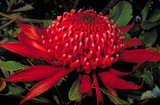 
Do they strike readily from cuttings or would a bud graft give me a better chance of success? There are several buds around the stem, if grafting is the best option can you advise the best root stock for growing in the Sydney region? Hoping you can help me with this problem.
Select the thumbnail image for a higher resolution image (33k).
Scott Fitz-Gerald
Sydney, Australia
Waratahs (Telopea speciosissima) can be struck from cuttings but best results usually come from using new seasons' hardened growth. This means taking cuttings in about January-February. You could try striking the flowering stem but I think the chances of success are less than 50%.
I don't know of anyone propagating waratahs by budding or grafting. I suspect that grafting onto a seedling waratah would be successful but I've never done it and I'm not aware of it being tried by enthusiasts or commercial growers.

Melaleuca products
I live in Colorado and we have imported some thatch-type material that is made of the Tea Tree "Mallalupa". I'm curious to find out if the Melaleuca found in Florida is anything close to what we're seeing here.
We have no plan of growing it. We were wondering if the product in Florida would be able to be used for the same purpose.
How is it being eradicated in Florida? Burning? Chemically? By cutting it down? Any info you can send would be most helpful.
Sally Henry
Colorado, USA
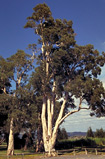 
The species that is causing problems in Florida is Melaleuca quinquenervia which is a widespread species in sub-tropical and tropical areas of eastern Australia, particularly in wet areas. This species also occurs in Papua New Guinea. It grows into a large tree.
Select the thumbnail image for a higher resolution image (33k).
The plant is so entrenched in Florida that eradication is probably unrealistic. A big problem is that the species (in fact all Melaleucas) store the seed on the plant for many years. The seed is only released on the death of the parent plant. So burning, and probably chemical treatment, would release masses of viable seed. Follow up treatment on the seedlings would need to be very diligent. There is some information on M.quinquenervia in Florida on our weeds page.
If the "thatch-type material" is like similar material in Australia it is made of dried branches of a very fine-leaved Melaleuca species. This is sometimes used to make fences and outdoor dividing walls. The species in Florida is a broad-leaved species which would drop its leaves when dried so the remaining stems wouldn't have the thatch-like effect.

Sandstone rubble
I'd be interested in any remarks you may care to make regarding the wisdom or folly of using sandstone rubble, perhaps with some kind of a compost, as a growing medium for native plants in the garden. Once again, thank you and regards for the new year!
Bruce Jones
Australia
There are probably as many theories on this as there are growers of Australian plants!
For what its worth, my view is that the most important factor in the successful growing of a wide range of Australian plants is good drainage. If the sandstone rubble helps in this then it should be fine. Another benefit may be in providing cool shelter for the roots of plants during hot, dry periods.
Anyone care to expound other theories??

Planting for nectar
I am interested in planting Australian native plants that are rich in nectar. This is to encourage Australian native bird species to my garden, and to provide a more natural diet to my rainbow lorikeet.
I live in the suburbs of Melbourne, Victoria, so any native plants you suggest must be suitable for this climate.
I have several "honey eaters" visiting my garden to partake of some of the varieties of plants that I currently have, but I feel that I can provide them with more.
Bernie Smith
Melbourne, Australia
(dynamicqs@one.net.au)
You're in luck!! There are many Australian plants which will be suitable. In general, any of the following are worth growing for attracting honeyeaters:
- Banksia, Grevillea, Eucalyptus, Correa, Callistemon, Melaleuca.
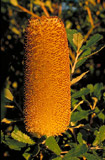 |
Banksias.....just great for honeyeating birds!!! This is Banksia media
Select the thumbnail image or plant name for a higher resolution image (34k).
|
As there are hundreds of varieties and species of these, it would be best to visit a specialist native nursery in Melbourne to find out what is available. They would also be the best people to recommend hardy plants for your soil and climate. You will find lists of nurseries in your general area at our nurseries page.

Solving a mystery?
With reference to Andrew and Yolande Winks' "mystery plant" in the last issue....
This looks exactly like the Caesalpinia gilliesii in my front yard. I presume it to be a South American native so it's a long way from home downunder.
Chris Nichols
Austin, Texas, USA
Chris advised that a photo of Caesalpinia gilliesii can be seen at
http://www.plantadviser.com/plants/caesgill.shtml
It does indeed look like the "mystery plant".

Fantastic flannels
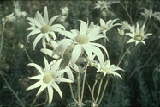 
Hello... hope someone can help.
I need some information on germinating Actinotus helianthi...flannel flower. I know it has to be smoke treated but not sure how to achieve this........
Select the thumbnail image for a higher resolution image (24k).
Alison Costello,
Australia
Flannel flowers are not the easiest plants to propagate from seed. Sometimes they germinate well without any treatment but more often they don't.
They may respond to smoke treatment (they often come up in their thousands after bushfires). The simplest way to do this is to sow the seeds and then build a fire on top of the pot - have enough twigs and leaves to keep the fire going for about 5 minutes or so. Then water and wait....and hope.
Another way is to use "smoke water" but this is not easily obtained. One company that sells it is Tenica Pty Ltd, PO Box 134 Bayswater Vic. Phone 03 97207705. They call their product "Regen 2000".
If you have access to any plants...propagation by cuttings is usually more satisfactory.

Reluctant flowering
I was wondering if anyone knows how to encourage Melaleuca nesophila to flower. We have had one in the garden at our church for about 8 years or more; it is a beautiful bush but hasn't had a single flower in all that time.
 
I was speaking to a Victorian who lives in NSW now and says that M.nesophila always flowers beautifully in Victoria which is attributed to more regular rain (when I think of my poor plant, never sees the hose). Also the climate is cooler, in fact, in its natural environment.
Select the thumbnail image for a higher resolution image (39k).
Jean Hatfield,
Hurstville, New South Wales
frankhat@bigpond.com
I was going to say "pray"...but I guess it's getting plenty of that!
My theory is that, if you make it think it's going to die, it will flower its head off. Perhaps you could lean an axe against the trunk through autumn and winter!
As you can guess...I haven't got a clue. Maybe others can help.

Propagating Allocasuarina
Does anyone have any helpful hints on how to germinate Allocasuarina torulosa seed?
I have tried to grow them for the last two seasons and have only got two or three trees from a box of 60 tubes.
Any help would be appreciated.
Helen Richards
Kangaroo Island, South Australia
I turned this one over to Jeff Howes, the newest member of our expert panel. Jeff, in turn, consulted his own expert...
"They are very easy to propagate from seed (according to the expert I consulted), however you must firstly pour boiling water over them and leave for 24 hours. Then sow them in a seed raising potting mix as usual. One problem you will encounter when you wet the seeds is that they all clump together due to the wing attached to the seed. You will need to spend sometime sorting out each seed - a bit fiddle but worth it as you will have a high success rate.
The seed raising mix my "expert" uses contains (approx) 4 parts peat, 3 sharp sand and 3 parts perlite. the mix is in the large seed trays (about 30 cms square) in nearly full sun and is watered twice a day.
Jeff Howes"

Aussie plants in Ireland
I am an enthusiastic grower from Belfast, Ireland and my son recently returned from Western Australia with 6 packets of seeds. They include Everlasting Daisy, Australian Grass-Tree, Kangaroo Paw, Western Australian Christmas Tree, Gungurru and Sturt Pea. Can these be grown as indoor plants at the start of our springtime?
Marie Lavery,
Ireland
micky@laverys.free-online.co.uk
Well...the last person to ask about growing Australian plants in Ireland is an Australian! But, ever willing to take on a challenge, I quickly passed this one over to Jeff Howes.
Quick as a flash, Jeff responded....
"An interesting question. I have often where those little packets of seeds end up. You have shed some light on that for me.
You should be able to get them to all to propagate with not too much trouble if you have a warm (20 degrees Centigrade) position with good light. However if you continue to grow them indoors in this situation they will become very spindly and week and they will, unfortunately not flower.
I would plant the Everlasting Daisy and Sturts Pea out in the garden in your springtime as they are used to cold overnight temperatures and they should flower for you quite quickly after planting.
As for the others, the grass tree needs 10 to 100 years to flower, the Kangaroo Paw 2 to 3 years to flower, the Christmas tree will never flower and the Gungurru (Eucalyptus caesia) needs 2 to 5 years. All this is assuming they adapt to your local conditions (doubtful).
Hope this helps you?
Jeff Howes"

Native versus exotic
Hi, my name is Jeanne, I was needing some information on growing native versus imported plants in Australia....what works well, different opinions, etc .
Jeanne,
Australia
This is a fairly broad question and I'm not quite sure what sort of info you need. You may need to do a bit of web browsing - try the links on our internet resources page as a starting point.
One of the problems in the native v/s exotic debate is in deciding what is meant by the term "native". Strictly speaking, a native plant is one that grows naturally in your own area (these are called "local" plants).. "Native" plants from other parts of Australia may be totally unsuited to your area because they come from an area with a completely different climate (and soils). For example, plants from south Western Australia where there are very dry summers and wet winters are often unsuccessful in Sydney and other east coast districts where summers are wet and humid. In this case the Western Australian plants are just as "exotic" as plants from America or Africa. Of course there are always exceptions and a reasonable number of WA plants grow well in the east just as many imported plants also grow well.
The arguments for growing local plants include:
- They are suited to the local climate and soils
- They are more likely to attract local birds and animals than foreign plants
- They are unlikely to "escape" and become environmental weeds in bushland
The last factor is probably the most important as many imported plants (both foreign and those from other parts of Australia) have become weeds.
Perhaps others would like to comment on this?

Dying (not dyeing!) grevilleas
I live in Southern California and have fallen in love with grevilleas -- but they aren't too happy with me!
I have tried to watch out for excess potassium, and I prepared the ground with non-compacted rich soil. I am afraid they will continue to systematically yellow and die back until they are dead. Can you help me?
There are three variables that I know of that could be potential problems - phosphate toxicity, irrigation water (chlorine or pH or even salts?), and maybe gophers.
My questions:
- Can you think of anything else I can investigate (that is, have I overlooked something)?
- How can I nurse them back to health if there has been phosphate toxicity? Drench them?
Thank you for your time -- I have searched for answers for several months to no avail. Nurserymen say "Oh, sometimes they just get yellow on you, it'll pass" - then the plant passes away... Internet searches have not helped much anyway. I am waiting for a soil test to give me
more information.
Sarah Santitoro
Simi Valley, California, USA
sarah@intumedia.com
It's difficult to satisfactorily answer a question like this from the other side of the Pacific but I'll have a go!
One problem is that there are many grevilleas from many different soils and climates. Some species will grow happily under conditions that will cause others to do poorly or die.
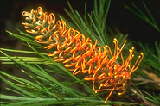 |
Grevilleas are probably the most popular Australian plants in cultivation.....but they can fail in the wrong conditions. This is Grevillea "Honey Gem", a reliable cultivar.
Select the thumbnail image or plant name for a higher resolution image (29k).
|
Something that could be a factor is the "rich soil". Most grevilleas are native to nutrient deficient soils and can take up excess nutrients when planted in rich soil. The problem nutrient in these cases is usually excess phosphorus, as you've suggested.
However, it's not necessarily the phosphorus itself that is the problem . Rather, excess phosphorus can prevent plants from taking up iron and this typically produces the yellowing that you have observed. The answer in such cases is to add a soluble iron to the plant and to the soil...."iron chelates" is a suitable form of iron and should be available at a garden centre. It's also possible that adding nitrogen as well as the iron will help the plants to recover.
A similar set of symptoms can arise if the soil is alkaline - this also locks up iron making it unavailable to plants. "Rich soils', in my experience, are more likely to be acid than alkaline but a pH check of the soil would at least help isolate the cause of the problem.
This is much more eloquently explained by Jim Barrow in "Understanding Soils and Nutrients" in this issue.
It might be worth seeking advice from the Santa Cruz Arboretum. They have an extensive collection of Australian plants and would have a better idea of your conditions than me. The URL is:
http://www2.ucsc.edu/arboretum/
Let us know if you manage to successfully revive the plants.

[Front Page] [Features] [Departments] [SGAP Home Page] [Subscribe]
Australian Plants online - March 1999
The Society for Growing Australian Plants
|